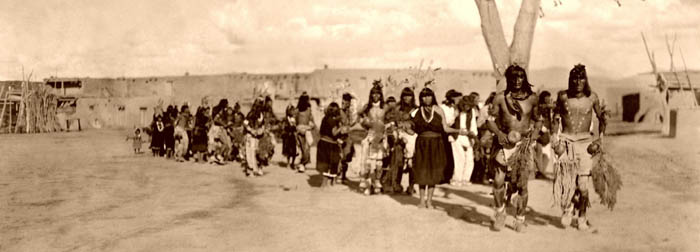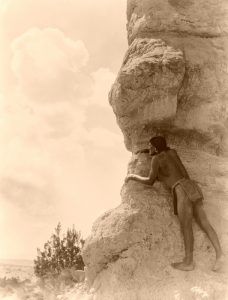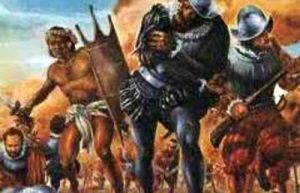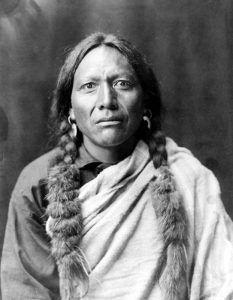The Tewa people are a group of Pueblo tribes belonging to the Tanoan linguistic family. They historically made their homes on or near the Rio Grande north of Santa Fe, New Mexico. Their name means “moccasins.”
Tewa culture shares many features with other Southwest Pueblos which derived from the Ancient Puebloans, also known as the Anasazi. These people once inhabited Mesa Verde in southwestern Colorado and extended southward following the upper Rio Grande and Chama Rivers in New Mexico and the San Juan River in Arizona.
In times past, each Tewa village was divided into two sections — the Winter people and the Summer people, and the Chief of each village would alternate between the two groups depending upon the season. The Tewa were farmers who developed hydraulic irrigation to water their principal crops of maize, beans, and squash. They also hunted deer, bison, elk, rabbit, birds, and other animals, and gathered berries, piñon nuts, wild greens, roots, and other fruits and vegetables.
They were involved in an extensive trade network throughout the Southwest, trading goods for items as far away as California, central Mexico, the Lower Mississippi Valley, and the Great Plains to the east.
In 1598, the Spanish conquistador Juan de Oñate established the Spanish capital of New Mexico at Yunque-Ouinge, a Tewa village located across the river from the San Juan Pueblo (now called Ohkay Owingeh.) At that time, Juan de Ciliate named 11 Tewa pueblos and stated there were others. The Spanish introduced new crops and livestock to the Tewa, who were soon also raising cows, pigs, and chickens and growing new crops and fruits.
The capital was later moved to San Juan Pueblo. From here, Oñate and his men subjected the Tewa and other Pueblo peoples to extraordinarily harsh rule in an attempt to force their conversion to Catholicism. Missions were established in all the pueblos.
The capital was moved to Santa Fe in 1609 when Pedro de Peralta replaced Oñate. By 1628, a Spanish missionary, Fray Alonzo Benavides, reported their population to be 6,000, living in eight pueblos.
By 1680, the Pueblo peoples developed a plan to remove the colonial oppression through the Pueblo Revolt, forcing the Spanish south of the Rio Grande. However, the Spanish returned in 1692, when Diego de Vargas began the reconquest of the Pueblos.
In 1696, a second Pueblo revolt occurred but was quickly put down. Afterward, many fled to northeast Arizona, where they lived with the Hopi Indians. During these years, rival Apache and Navajo raids for food and captives, increased. As these attacks intensified, the Pueblos began to take advantage of Spanish military assistance.
By the early 1900s, their population had been reduced to about 1,200. However, it then began to increase and showed a steady climb after the Pueblo Lands Board settled the land claims in 1920. Between 1950 and 1964, the population in all six of the Tewa Pueblos nearly doubled.
Today, the Tewa live primarily in the Nambé, Pojoaque, San Ildefonso, Ohkay Owingeh (formerly known as San Juan Pueblo), Santa Clara, and Tesuque Pueblos in northeastern New Mexico; with some descendants also residing on the First Mesa Hopi Reservation in Arizona.
Numerous Pueblo ruins remain in north-central and northwestern New Mexico that are ancestral sites of the contemporary Rio Grande Pueblos. At least 60 pueblos were abandoned in historical times, many of which can be directly tied to Tewa villages.
Also See:
Missions & Presidios of the United States
Pueblo & Reservation Etiquette
Sources:




